Join More Than 50,000+ Subscribers and get latest camera news and rumors
NEW CAMERA VIDEOS ON YOUTUBE
|
By admin, on August 12th, 2024
Let’s discuss the best entry-level camera for photographers. In this particular article, we will compare all the entry-level camera sensors at high ISO range to each other to find out the best of all.
The list of cameras that we have included in this test starts with Sony’s most popular 24-megapixel APS-C CMOS sensor. The Sony 24-megapixel APS-C BSI CMOS sensor is being used in the following models:S
Sony A6100
Sony ZV-E10 Mark II
Sony A6400
We have selected Nikon’s famous 20-megapixel APS-C CMOS sensor, being used in these Nikon cameras:
Nikon Z30
Nikon Z50
Nikon Zfc
And finally, Canon’s 24-megapixel APS-C DPAF CMOS sensor, the latest generation of the sensor, is being used in:
Canon R50
Canon R10
The Canon R100 camera sensor as well as the processor used in R100 is not coming straight from Canon’s latest generation of sensors, so we are putting this camera on the sap-rate list
From the editor’s desk:
In this comparison, we will be evaluating the image sensors of all these cameras together to find out which one performs best in low-light and uncontrolled lighting environments.
Are you planning to buy a new camera for photography? Whether you’re interested in kids’ photography, shooting portraits of your family and friends, capturing landscapes, architecture, or even wildlife photography, in any of these scenarios, you will be exposed to uncontrolled lighting environments.
What does an uncontrolled lighting environment mean? It means dealing with natural light, which is not always perfect as per your requirements.
So, what does a photographer do to adjust for natural light? They generally raise the ISO level to balance the exposure.
The truth is, If your camera sensor cannot perform well at high ISO levels, then it’s likely not the right choice for you. In this comparison, we will be reviewing all these models so you can easily find the best camera for your needs.
1. Canon R100 vs Canon R10/R50
We are comparing Canon are 100 camera versus The Canon R10 / r50 by picking up the ISO 12800 now let’s see the image below and discuss the result
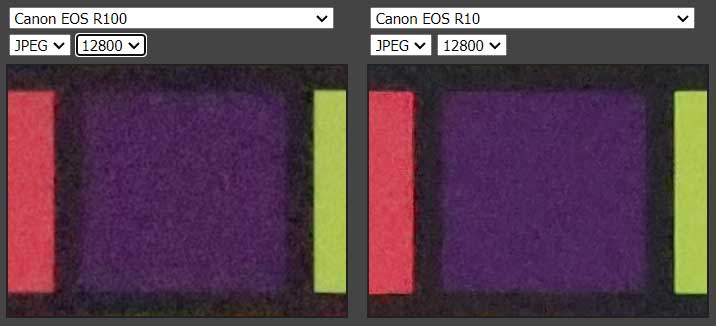
As seen in the test results, you can clearly notice that the image sample captured at ISO 12800 with the Canon R100 camera does not preserve details as well as the Canon R10.
What could be the reason behind this? It could be due to the older generation of the sensor or perhaps the older generation of the image processor used in the Canon R100. It could be either of these two factors, but the end result is clear: the Canon R50 camera’s sensor performs much better compared to the Canon R100.
Verdict: Winner Canon R10/Canon R50 Camera
2. Canon R10/R50 vs Sony ZV-E10/A6400
Now it’s time for the most interesting comparison. We are comparing the Canon R10 and R50’s 24-megapixel Dual Pixel CMOS autofocus sensor with Sony’s 24-megapixel Hybrid CMOS autofocus sensor, which is used in the Sony ZV-E10, Sony A6400, and Sony A6100 cameras. This comparison will be very interesting to see which one performs better under various conditions.
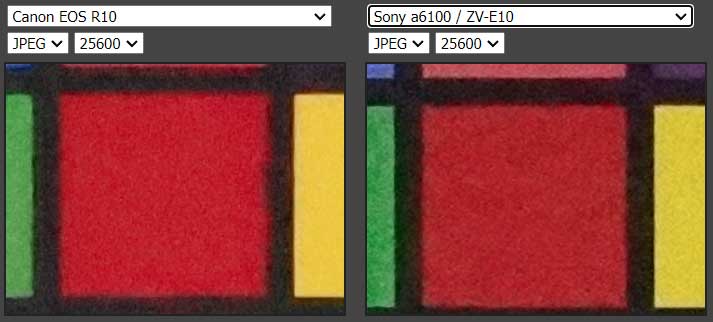
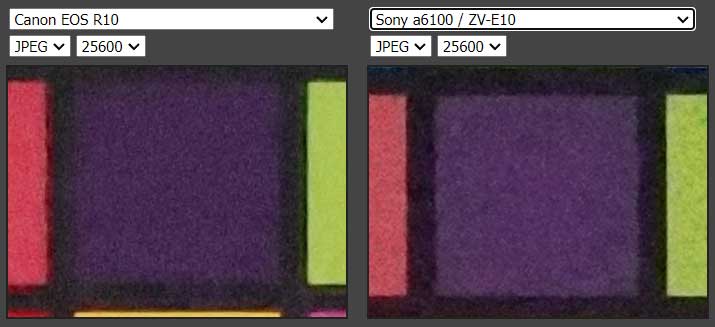
From the image samples, it is very clear that Sony’s 24-megapixel Hybrid CMOS autofocus sensor is able to capture slightly more detail—or rather, it’s better to say it’s able to preserve slightly more detail—compared to the Canon R10 and Canon R50’s 24-megapixel Dual Pixel CMOS autofocus sensors.
We’re not talking about a major difference, but there is a noticeable one. You can observe it in the corners and edges of the color blocks, where the sharpness and details are better preserved by Sony’s sensor at high ISO ranges compared to the Canon R10.
Verdict: Winner Sony ZV-E10 | Sony A6400 Camera
3.Sony ZV-E10/A6400 vs Nikon Z30/ Z50
Now it’s final test time, and we are comparing the Sony ZV-E10 or the Sony A6400 camera Hybrid CMOS autofocus sensor with the Nikon Z30 or Z50. We do have a slight resolution difference between them, and we will be comparing both at the same. Let’s find out the difference we have.
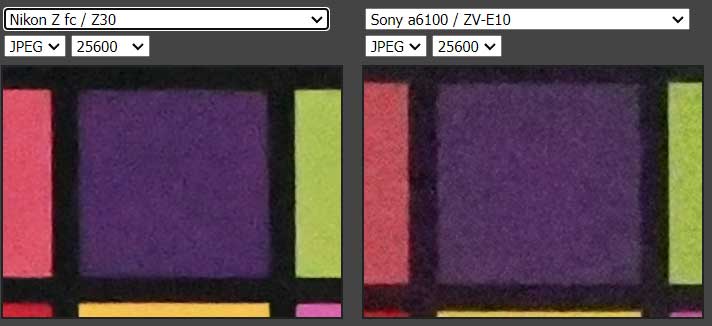
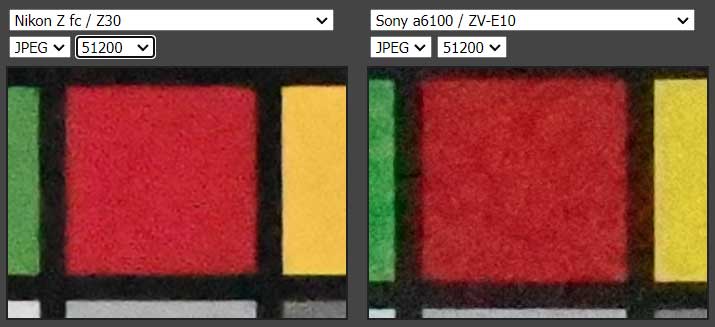
We have selected two different image samples at two different ISO levels. The first one is at ISO 25600, and the other set of samples is at ISO 51200. In both images, it is clearly visible that the Nikon Z30, Zfc, or Z50 20-megapixel Hybrid CMOS autofocus sensor wins by a margin. It preserves a bit more detail; the corners and the borders are a bit clearer and better preserved compared to the image samples we have on the right side from the Sony A6100 or the Sony ZV-E10.
From the test, it’s very clear that the 20-megapixel Hybrid CMOS autofocus sensor of the Nikon Z30 is able to preserve a bit more detail.

Final Result and the Winner
If you are going to combine all the tests and conclude a result, then the clear winner in the entry-level zone is the Nikon Z30, Z50, or Zfc with the 20-megapixel Hybrid CMOS autofocus sensor. If you want to shoot amazing images in uncontrolled light or low-light environments, then without a doubt, even in 2024, this sensor is best for you.
Get Nikon Z30 | Nikon Z50 | Nikon Zfc from Amazon.com | B&H Store
PS: Keep in mind that several other factors are also involved, like the autofocus system, continuous burst speed, and types of autofocus modes, but we are discussing the most important part here: the image quality, which matters the most to a photographer.
We Need Your Love and Support: How can you support TheNewCamera.com? Simply by purchasing your new camera, lens, or any other accessories through our affiliate links, which will help us maintain this website.
source image credit – www.dpreview.com/reviews/image-comparison
By admin, on March 10th, 2024
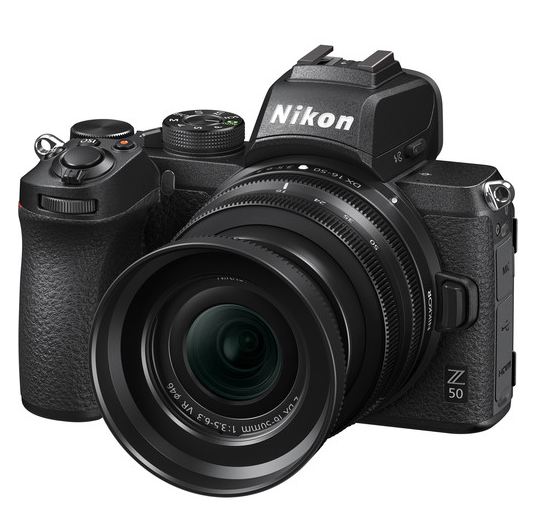
Best Lenses for Nikon Z50 camera. Let’talk about the best lenses available for the Nikon Z50 camera. We know at this moment very limited lenses are available for Nikon Z DX mirrorless camera so we have also included some essential lenses from the DX-format DSLRs which can be paired up with lenses.
UPDATE: Now we have many options for the Nikon Z50 camera in the year 2024 from third-party lens makers. Nikon also announced a lot of lenses in the past three years. This guide is updated to help you pick the best lenses available for the Nikon Z50 camera in 2024.
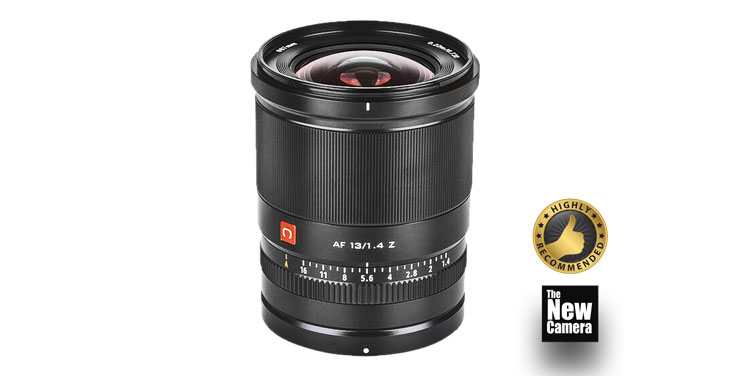
1. Viltrox 13mm f1.4
Best Lens for shooting handheld vlogs under any light | Also perfect for shooting landscape and architecture
Get Viltrox 13mm F1.4 Lens from B&H Store and Amaon.com
If you want the perfect wide-angle lens and you don’t have any budget constraints, then without a doubt, having a Viltrox 13mm f1.4 lens will be a great boost to your lens arsenal.
This lens is ideal for landscapes, cityscapes, architecture, and much more with its 13mm ultra-wide coverage. You are getting an exceptional f1.4 maximum aperture, which is not possible with any other lens available for the Nikon Z mount as of now.
So, if you want a lens that performs exceptionally well in uncontrolled light environments or low light without having a second thought, you should buy this lens.
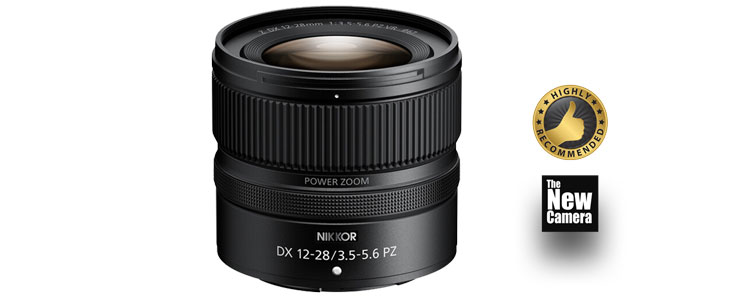
2. Nikon Z DX 12-28mm F3.5-5.6 PZ VR
Perfect Budget Zoom Lens for Vlogging, Nikon announced the 12-28mm Lens for content creators | Get 12-28mm Lens from Amazon.com | B&H Store
For a more affordable option, consider Nikon’s latest announcement, the 12-28mm lens.
This is a very versatile lens covering distances from 12mm to 28mm, providing flexibility to zoom in and out and recompose your frame at your convenience. At the same time, it offers a variable aperture starting from f3.5 to 5.6. The main reason we recommend this lens is that Nikon has added optical image stabilization to compensate. It works up to 4.5 stops, so even in low-light environments, you will get stable footage and crisp pictures, even when shooting at slower shutter speeds.
The next lens we recommend to you is the Viltrox 20mm f1.8, which is a prime lens and also a budget-friendly option.
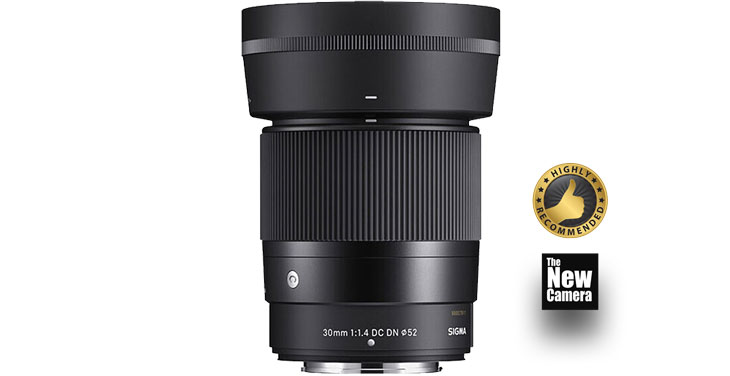
3. Sigma 30mm F1.4 Lens for Portrait
Perfect Lens for Professional Portraits and Office | Room and Cooking Videos | Get this Lens from B&H Store | Amazon.com |
So let’s talk about the best portrait lens for everyday use with the Nikon Z50 camera, if you are interested in portrait photography and would like to invest in a lens that will give you a kind of professional output whether you are shooting portraits with this lens or creating cinematic videos or reels in your home and less space, The 30mm F1.4 from Sigma is best for pro use.
Sigma 30mm 1.4 lens generates an angle-of-view similar to a 45 mm standard portrait lens when used with a Nikon z50 camera
The background blur or bokeh of this lens is outstanding and unlike the camera, the lens is weather-sealed as well so you can use it in any of the weather conditions you would like to.
We highly recommend you get this lens if you are interested in portrait photography this is the best lens for the Nikon z50 camera
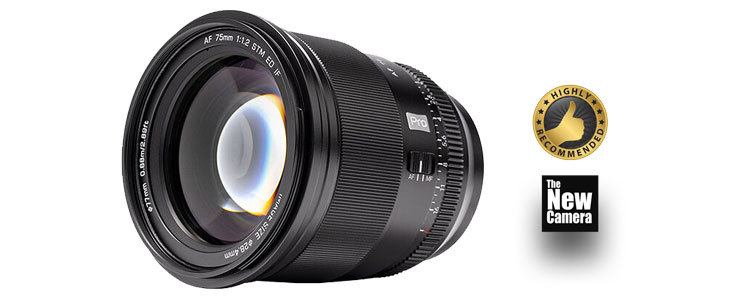
4. Viltrox DX 75mm F1.2 Z Mount Lens | PRO PORTRAIT LENS
BEST PRO PORTRAIT LENS FOR NIKON Z MOUNT | Requires Good working distance | Get 75mm F1.2 Lens from Amazon.com | B&H tore
If you are a professional portrait photographer with a large working space or studio, or if you can work with clients in parks and streets it’s very important to maintain a perfect working distance of 15 to 20 feet with your clients while using this lens to achieve phenomenal output. Otherwise, a crop portion of the body will be captured.
The Angle of View of the 75mm F1.2 Lens is 150mm @ 35mm eg. So, so you can use ur using 150mm F2 Lens is your full-frame camera for portraits.
This is the best portrait lens specifically built for DX-format cameras. However, it requires a significant working distance from your subject. If maintaining a good working distance is not possible in your workflow, it is not recommended to buy this lens. Consider buying this lens only if you can work with a good working distance.
The lens produces output that is completely unmatched compared to other portrait lenses available for the Nikon DX mount. HIGHLY RECOMMENDED
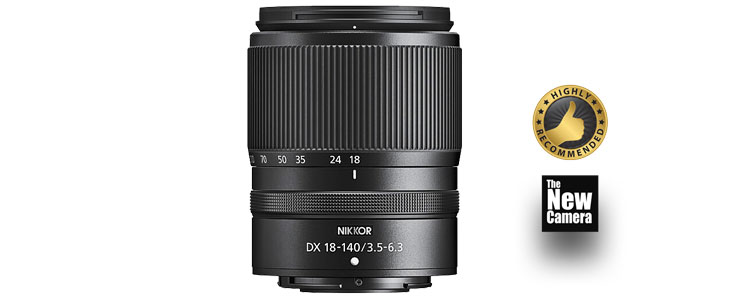
5. Nikon Z DX 18-140mm f/3.5-6.3 VR
Best coverage lens for wedding photographers | Get 18-140mm Lens from Amazon.com | B&H store
So, the best coverage lens for wedding photographers who are using the Nikon Z50 camera is the Nikon Z 18 to 140 mm lens. This lens has been popular since the DSLR era and has finally it has been arrives for for mirrorless users.
The lens also features an optical image stabilization system, despite of having variable aperture that creates a lot of trouble in lowlight situation the OIS will help you to get slower shutter speed. The lens is perfect for covering an event. However, you may not be able to capture perfect candid moments with this lens. For that, you have to wait for the Tamron 17 to 70 mm f/2.8 lens to arrive in the Nikon Z mount. But until that lens arrives, this is the best lens for coverage purposes.
If you are a travel photographer and want to have an all-in-one lens for your Nikon Z50 camera, again, the 18 to 140 mm lens is the most recommended lens for you.
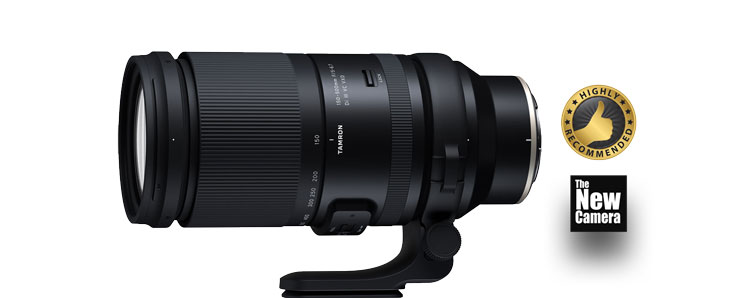
6. Tamron 150-500mm f/5-6.7 Di III VC VXD Lens (Nikon Z)
Best zoom lens for wildlife photographers | Get 150-500mm Lens form Amazon.com | B&H Sore
if you can increase your budget a little bit more and want to have the best available wildlife photography lens for your Nikon Z50 camera, without a doubt, you should go with the Tamron 150 to 500 mm f/5 to 6.7 lens.
The lens will act as a 225 to 750 mm lens when used with a Nikon DX format camera like the Nikon Z50.
This lens is fully compatible with hybrid autofocus features as well as Eye autofocus feature with the help of its recently developed VXD (Voice-coil eXtreme-torque Drive) linear motor focus mechanism delivers extreme high-speed and high-precision movement and ensures exceptionally responsive performance and is compatible with Nikon Hybrid AF and Eye AF features in enabled cameras.
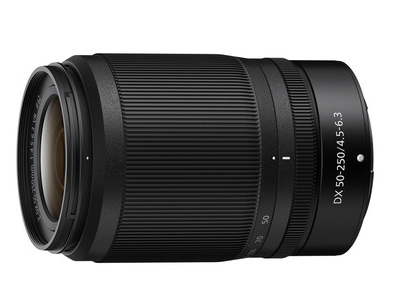
7. Zoom Lens for Nikon Z50 Camera under budget
Apart from kit lens, only one lens is available for DX Mirrorless camera right now and the name of the lens is NIKKOR Z DX 50-250mm f/4.5-6.3 VR Lens. The extremely sharp, quick, and light. Highly recommended if you want a handy zoom lens for your DX-format camera. Its compact, balanced design and Vibration Reduction technology help keep photos sharp and videos steady, and the lens’ fast, quiet autofocus system minimizes camera noise during video recording.
By admin, on May 16th, 2023
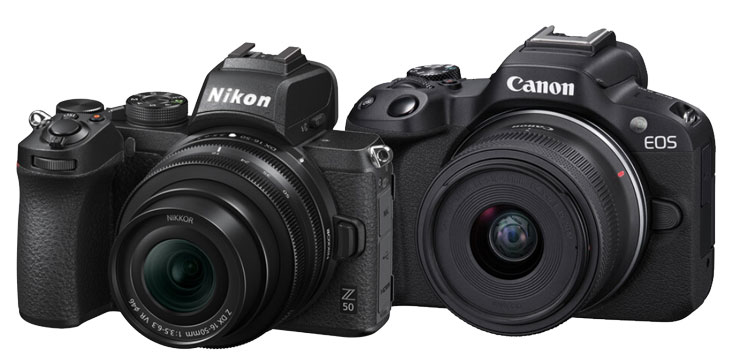
Latest comparison of the design part of the Canon R50 versus the Nikon Z50 camera. Canon R50 features a very ultra-compact body. The big difference between the two is weather sealing. If you shoot mostly outdoors, Z50 and even Z30 feature weather sealing in their body. No weather sealing is present in Canon R50.
Both cameras feature a built-in flash as well as an EVF. They are almost the same. The Canon R50 features a vari-angle display, while the Nikon Z50 features a limited-tilt display screen.
Canon R50 vs Nikon Z50 – Table of contents
Due to the design issue, the Canon R50 camera is more content-creator-friendly when compared to can Nikon Z50
also, see – Canon R10 vs Nikon Z50
Best Lenses for Canon R50 Camera
|
Canon R50 |
Nikon Z50 |
| Lens Mount |
Canon RF |
Nikon Z |
| Sensor Resolution |
Effective: 24.2 Megapixel |
Actual: 21.51 Megapixel
Effective: 20.9 Megapixel (5568 x 3712) |
| Image Sensor |
22.3 x 14.9 mm (APS-C) CMOS |
23.5 x 15.7 mm (APS-C) CMOS |
| Crop Factor |
1.6x |
1.5x |
| Image Stabilization |
None |
Digital (Video Only) |
| Built-In ND Filter |
None |
None |
| Capture Type |
Stills & Video |
Stills & Video |
1. Best Camera for Photography – Canon R50 vs Nikon Z50
Both cameras use an APS-C CMOS sensor. Nikon calls it DX and as you can see, physically the DX sensors are slightly larger compared to the Canon APS-C sensor.
- Nikon’s DX: 23.5 mm x 15.7 mm
- Canon’s APS-C: 22.3 × 14.9 mm
Okay, that doesn’t make too much difference, but since the sensor resolution of Nikon Z50 is 20MP and the sensor size is slightly larger, then due to these two factors automatically the low light performance of the camera upscales compared to others.
If you look at the ISO range chart, then you will see a massive difference between the ISO range of the Canon R50 camera and the Nikon Z50. The maximum ISO range of the Canon R50 camera goes up to ISO 51200 whereas the Nikon Z50’s ISO range is expandable up to 204800.
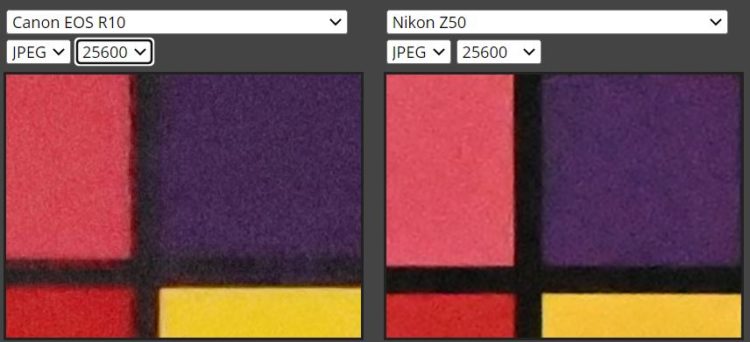
Since R10 samples are not available at this moment we are picking up, the Canon R10 (both Canon R10 and R50 share the same sensor)
Not only in words and numbers, let’s compare the two practices and try to find out the best camera between these two. As you can see, the ISO range of the Canon camera limits to 25600. Comparing the two, it’s very clear that the Nikon Z50 camera is able to preserve color details in a much better way. As you can see, the color box lines are not melting into each other. Canon R50 is not able to resolve colors at higher ISO ranges.
|
Canon R50 |
Nikon Z50 |
| Shutter Type |
Electronic Shutter |
Electronic Shutter, Mechanical Focal Plane Shutter |
| Shutter Speed |
Electronic Shutter
1/8000 Up to 30 Seconds
Electronic Front Curtain Shutter
1/4000 Up to 30 Seconds |
Electronic Front Curtain Shutter
1/4000 to 30 Seconds
Electronic Shutter
1/4000 to 30 Seconds |
| Bulb/Time Mode |
Bulb Mode, Time Mode |
Bulb Mode, Time Mode |
| ISO Sensitivity |
Photo/Video
100 to 32,000 (Extended: 51,200) |
Photo
100 to 51,200 in Auto Mode (Extended: 100 to 204,800)
Video
100 to 25,600 in Manual, Auto Mode |
| Metering Method |
Center-Weighted Average, Evaluative, Partial, Spot |
Center-Weighted Average, Highlight Weighted, Matrix, Spot |
| Exposure Modes |
Aperture Priority, Manual, Program, Shutter Priority |
Aperture Priority, Manual, Program, Shutter Priority |
| Exposure Compensation |
-3 to +3 EV (1/3 EV Steps) |
-5 to +5 EV (1/3, 1/2 EV Steps) |
| Metering Range |
-2 to 20 EV |
-4 to 17 EV |
| Continuous Shooting |
Electronic Shutter
Up to 15 fps for up to 28 Frames (JPEG) / 7 Frames (Raw)
Electronic Shutter
Up to 12 fps for up to 42 Frames (JPEG) / 7 Frames (Raw) |
Up to 11 fps at 20.9 MP
Up to 5 fps at 20.9 MP
Up to 4 fps at 20.9 MP
Up to 30 fps at 8 MP |
2. Autofocus – Canon R50 vs Nikon Z50
Both of them use completely different technology. Canon uses Dual Pixel CMOS autofocus technology and Nikon uses hybrid.
- The Canon R10 DPAF points are fabricated across the entire sensor, with a maximum of 4,503 points (single area mode) or 651 ZONES (when Tracking is enabled).
- The Z50 has 273 points that cover approximately 90% of the sensor. So technically we have less number of AF points inside the Nikon Z50 Mirrorless camera.
|
Canon R50 |
Nikon Z50 |
| Focus Type |
Auto and Manual Focus |
Auto and Manual Focus |
| Focus Mode |
Continuous-Servo AF, Manual Focus, Single-Servo AF |
Automatic, Continuous-Servo AF, Full-Time Servo, Manual Focus, Single-Servo AF |
| Autofocus Points |
Photo
Phase Detection: 4503
Video
Phase Detection: 3713 |
Phase Detection: 209 |
| Autofocus Sensitivity |
-4 to +20 EV |
-2 to +19 EV |
If you compare the autofocus points of the two, then you will see a massive difference. Don’t get demoralized after looking at the fewer number of points in Nikon Z50 camera. It is also highly usable and a perfect companion for general-purpose photography. You can also shoot sports and wildlife with this but don’t expect Hi-Fi 3D AF tracking performance from this camera.
If you are more into sports and wildlife photography and love to have a perfect camera under budget, then I highly recommend you to get the Canon R50 camera if possible, which has the fastest burst speed of 23 frames per second.
3. Best Camera – AF sensitivity – Canon R50 vs Nikon Z50
The stats say, the Canon R50 has a minimum sensitivity in the low light of -4EV, which is excellent for a class of camera like the Canon R10. The AF sensitivity of measured with an F1.2 lens is practically impossible to buy for beginners. So, it’s eq to – 2.5EV with an F2 lens.
Z50 has a rating of -2EV, or -4EV if you activate the Low Light AF mode (which is slower but can help in very dim light conditions). This data is measured with an F2 lens.
The R50 has a few extra features concerning autofocus, like focus bracketing and focus stacking which will interest macro photographers. So technically if he takes all the aspects here in terms of autofocusing performance of the two cameras then Canon R50 is a clear winner.
4. Best Camera for Sports and Wildlife – Canon R50 vs Nikon Z50
The Canon R50 camera doesn’t have any fully mechanical shutter, neither does the Nikon Z50. The Nikon Z50 specification says it has a mechanical focal plane shutter, but once we enter into the specs of the camera, we are able to witness only two shutters and these are:
Not able to see mention of any fully mechanical shutter. In the same way, even Canon R50 camera doesn’t have a fully mechanical shutter.
Now Canon is able to utilize its electronic shutter even when you are using the burst speed of the camera, but in Nikon Z50 we are limited to the use of only a mechanical shutter in high-speed burst mode. Since the camera doesn’t have a stacked CMOS sensor, there is literally no use in boosting up your shutter speed on electronic shutter steroids. You will have a massive rolling shutter effect in your images.
We highly recommend you go with Nikon Z50 for sports and wildlife photography. If you can spend more, then only Canon R10.
|
Canon R50 |
Nikon Z50 |
| Internal Recording Modes |
H.264/H.265/MPEG-4
UHD 4K (3840 x 2160) at 23.98/25/29.97 fps
1920 x 1080 at 23.98/25/29.97/50/59.94/100/120 fps |
H.264/MOV/MP4
UHD 4K (3840 x 2160) at 23.98/25/29.97 fps
1920 x 1080p at 23.98/25/29.97/50/59.94/100 fps |
| Broadcast Output |
NTSC/PAL |
NTSC/PAL |
| Recording Limit |
Stereo |
Stereo |

5. Best Camera for Video – Canon R50 vs Nikon Z50
Both can record 4K videos up to 30 frames per second. Due to the use of a low light sensitive sensor in Nikon Z50, you are able to capture uncontrolled light videos in a better way. Even at higher ISO, Nikon Z50 camera is able to preserve more details, as we have already seen in the ISO test.
The Canon R50 has an amazing ability to record 10-bit HDR PQ videos. But at the same time, you need additional lights to get the maximum out from the R50 sensor. Otherwise, in an uncontrolled light environment, the quality goes even below that of Nikon Z50’s 8-bit output.
So if you are working in an uncontrolled light environment where you do not have any access to dedicated lights, you should buy the Nikon Z50. Otherwise, if you’re working with lights and in your studio, then Canon R50 is a better choice.
6. Content creators and bloggers
The best camera for you is Canon R50 due to its flexible vari-angle display screen. Nikon Z50’s screen rotates in a 180-degree fashion which is not that much usable. It’s better to buy Canon R50.
|
Canon R50 |
Nikon Z50 |
| Battery Type |
1 x LP-E17 Rechargeable Lithium Polymer, 7.2 VDC, 1040 mAh |
1 x EN-EL25 Rechargeable Lithium-Ion, 7.6 VDC, 1120 mAh (Approx. 300 Shots) |
| Tripod Mounting Thread |
1 x 1/4″-20 Female (Bottom) |
1 x 1/4″-20 Female (Bottom) |
| Dimensions (W x H x D) |
4.6 x 3.4 x 2.7″ / 116.3 x 85.5 x 68.8 mm |
4.98 x 3.68 x 2.36″ / 126.5 x 93.5 x 60 mm |
| Weight |
13.2 oz / 375 g (With Battery, Recording Media)
11.6 oz / 328 g (Body Only) |
13.93 oz / 395 g (Body Only)
|
Help us to get a Barista Coffe
Latest Price of Nikon Z50 B&H | Amazon.com
Get Canon R50 From Amazon.com | B&H Store
By admin, on June 8th, 2022
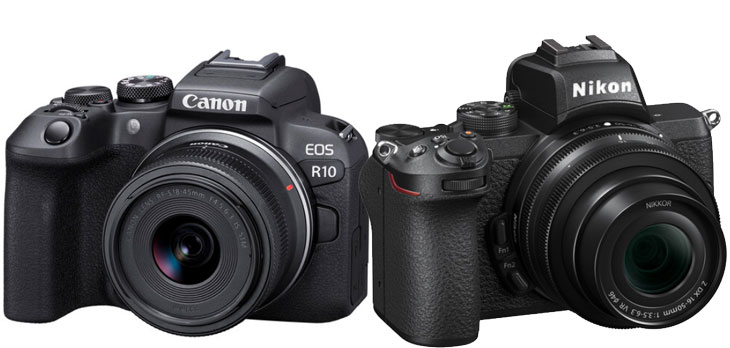
Let’s compare the Canon R10 vs the Nikon Z50 camera. Let’s discuss the major difference between the two. As we know the Canon R10 arrived with a conventional CMOS sensor and due to that Nikon Z50 is able to create space again with its low-light advantage
| Lens Mount |
Canon RF |
Nikon Z |
| Sensor Resolution |
Actual: 25.5 Megapixel
Effective: 24.2 Megapixel |
Actual: 21.51 Megapixel
Effective: 20.9 Megapixel (5568 x 3712) |
| Sensor Type |
22.3 x 14.9 mm (APS-C) CMOS |
23.5 x 15.7 mm (APS-C) CMOS |
| Crop Factor |
1.6x |
1.5x |
| Image Stabilization |
Digital (Video Only) |
Digital (Video Only) |
| Built-In ND Filter |
None |
None |
| Capture Type |
Stills & Video |
Stills & Video |
Image sensor & Low-light performance
Both sensors are made on conventional CMOS Sensor technology. None of them features a BSI sensor. But if we consider the two most important factors that we have here is
1. Expandable ISO range
2. 12% larger sensor pixel in Nikon Z50
Due to the larger pixel area, the sensor can grab more light compared to Canon R10 Sensor. And hence we do expect despite the refinements Canon has done with the R10 sensor despite keeping the sensor core technology the same. We will see at least 1 stop of improvement in the Nikon Z50 low light performance compared to the Canon R10
Canon R10 Has arrived on the market but
If you are more concerned about the low light performance of the camera then even in 2022, Nikon Z50 is an excellent option for photographers.
If ur having doubts about the AF performance then don’t worry the AF performance of the camera is much improved after the Nikon firmware 2.2 updates. The camera is now able to track animals’ eyes too. The overall AI AF of the camera is also much improved.
Slightly more rich Lens ECO system in Nikon – Right now if we compare the Canon RF mount ECO system vs Nikon Z mount ECO system the Nikon is now a collaboration with Tamron and they have started with 28-75 F2.8. Not only that, Viltrox also has an amazing range of Nikon Primes right now.
Nikon APS-C Viltrox Lenses B&H Store
Yes, we do have rumors about Viltrox lenses coming for RF Mount too, but if someone is planning to buy Nikon Z50 right now, then its more feasible to buy the Nikon Z50 camera only for photography purposes (Like weddings, street, and Portraits)
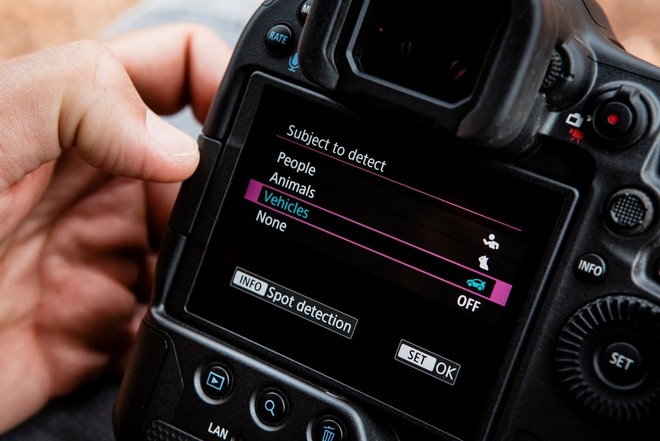
Canon R10 For Sports Shooter. Wildlife Photographers
Canon R10 has just arrived with class-leading AF performance., Canon implemented DPAF gen 2 inside Canon R10 & R7 both. According to Canon’s official press release, the AF performance of the recently announced Canon R10 and Canon R7 cameras is similar to Canon EOS R3 camera. Although we never consider it exactly similar neither they can perform so, due to the lack of a Stacked CMOS sensor like we have in the Canon R3.
651 AF Zones inside Canon R10
Yes, we have 651 AF Zones inside the Canon R10 camera which is comprised of more than 2.9k DPAF points. The AF tracking mode has dedicated 3d subject tracking modes in the Canon R10 camera. Whereas our Nikon Z50 is limited to 205 Hybrid AF points.
Overall, we can say that the AF system of the Nikon Z50 after the arrival of firmware F2.2 has become very usable but the Canon R10 AF system is phenomenal and the best in its class.
| Focus Type |
Auto and Manual Focus |
Auto and Manual Focus |
| Focus Mode |
Continuous-Servo AF, Manual Focus, Single-Servo AF |
Automatic, Continuous-Servo AF, Full-Time Servo, Manual Focus, Single-Servo AF |
| Autofocus Points |
Photo, Video
Phase Detection: 651 AF Zones |
Phase Detection: 209 |
| Autofocus Sensitivity |
-4 to +20 EV |
-2 to +19 EV |
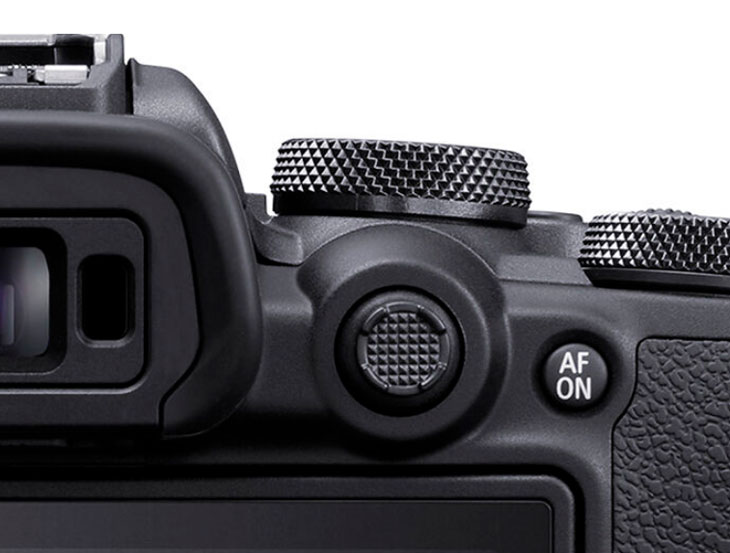
Canon R10 also features a Joystick controller on the rear side of the camera. A helpful tool for professional photographers is now available in the mid-range cameras.
Canon R10 Fastest in its Class
However, being said, if we talk about the stats of the Canon R10 camera, in continuous shooting mode the camera is able to capture 23 Frames @ elec. shutter and 15 FPS with the help of a mechanical shutter. The Buffer depth is also very usable and ur able to capture up to 70 JPEG files @ 23 FPS and up to 450+ files @ 15fps in a single burst.
Either ur shooting at 23 FPS or 15 FPS, the DPAF system is fully active and tracks moving 3d subjects very well.
| Shutter Type |
Electronic Shutter, Mechanical Focal Plane Shutter |
Mechanical Focal Plane Shutter, Electronic Shutter |
| Shutter Speed |
Mechanical Shutter
1/4000 to 30 Seconds
Electronic Shutter
1/4000 to 30 Seconds |
Electronic Front Curtain Shutter
1/4000 to 30 Seconds
Electronic Shutter
1/4000 to 30 Seconds |
| Bulb/Time Mode |
Bulb Mode |
Bulb Mode, Time Mode |
| ISO Sensitivity |
Photo
100 to 32,000 in Manual, Auto Mode (Extended: 100 to 51,200) |
Photo
100 to 51,200 in Auto Mode (Extended: 100 to 204,800)
Video
100 to 25,600 in Auto, Manual Mode |
| Metering Method |
Center-Weighted Average, Evaluative, Partial, Spot |
Center-Weighted Average, Highlight Weighted, Matrix, Spot |
| Exposure Modes |
Aperture Priority, Manual, Program, Shutter Priority |
Aperture Priority, Manual, Program, Shutter Priority |
| Continuous Shooting |
Electronic Shutter
Up to 23 fps at 24.2 MP for up to 70 Frames (JPEG) / 21 Frames (Raw)
Mechanical Shutter
Up to 15 fps at 24.2 MP for up to 460 Frames (JPEG) / 29 Frames (Raw) |
Up to 11 fps at 20.9 MP
Up to 5 fps at 20.9 MP
Up to 4 fps at 20.9 MP
Up to 30 fps at 8 MP |
Best Camera to capture Video
Canon R10 is the best camera to capture High-Quality video, let me explain this. When we are comparing Nikon Z50 and Canon R10 then we will consider both the features and the limitations, let’s discuss the both
Both of them create 4k videos via the oversampling method. Although in Canon R10, we get an option to record 4K 24 / 30 fps video in 10bit format, and in Nikon Z50 we are limited to 8bit. None of them allow us to use Log files from them. And finally, with the Canon R10, we also have an option to record 4K 60p video @ 1.56x crop (although it’s not that usable with the crops factor) but yes we are getting, at least an option that is not available in Nikon Z50 camera.
With Canon HDRPQ mode the Canon R10 is able to record 10Bit videos in H.265 codec @ 170Mbps. So, 10bit in any form is very useful if you know the difference between the 10bit and 8bit video files.
No recording limit, Canon has revoked the recording limit of the recently announced cameras, both the Canon R10 and Canon R7 don’t have any recording limit. But, in the Nikon Z50 camera, we do get a recording time limit of 30min.
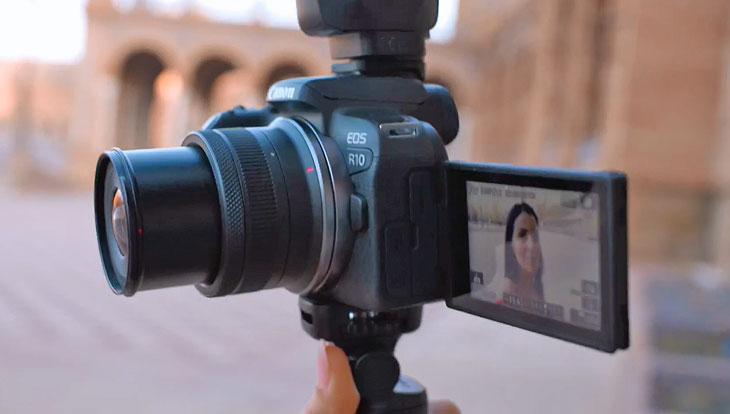
Perfect for Vloggers with a vari-angle display screen.
| Recording Modes |
H.264/MP4 4:2:0 8-Bit
UHD 4K (3840 x 2160) at 23.98p/25p/29.97p/59.94p
Full HD (1920 x 1080) at 23.98p/25p/29.97p/50p/59.94p/100p/119.88p
H.265/MP4 4:2:2 10-Bit
UHD 4K (3840 x 2160) at 23.98p/25p/29.97p/50p/59.94p
Full HD (1920 x 1080) at 23.98p/25p/29.97p/50p/59.94p/100p/119.88p |
MOV/MP4/H.264
UHD 4K (3840 x 2160) at 23.98p/25p/29.97p
Full HD (1920 x 1080) at 23.98p/25p/29.97p/50p/59.94p/100p/119.88p |
| Gamma Curve |
HDR-PQ |
NA |
| Video System |
NTSC/PAL |
NTSC/PAL |
| Limit |
No limit |
30 Min |
| Audio Recording |
MP4: 2-Channel AAC Audio |
AAC Audio
LPCM Audio |
Verdict:
For general purpose photography the Nikon Z50 camera is still usable and you can buy that camera if you want to, the added advantage you will have with the Nikon Z50 camera is the 1 stop better low-light performance. The Z50 AF has improved from the time of announcement and now it has become usable to max extent.
Those Who are Hybrid Shooters (Photo Video both), Contest creators aka YouTubers, Sports shooters, and wildlife photographers, we recommend you to get associated with the Canon R10 camera.
Leatest Price of Canon R10 at B&H Store and Amazon.com | B&H Store
Latest Price of Nikon Z50 B&H | Amazon.com
Also, see – Canon R10 vs Sony ZV-E10
Also, see – Canon R10 vs Sony A6400
See All Comparison & Content Related to Canon R10 Here
Best Lenses for Nikon Z50
More Specs Comparison
| Media/Memory Card Slot |
Single Slot: SD/SDHC/SDXC (UHS-II) |
Single Slot: SD/SDHC/SDXC (UHS-I) |
| Video I/O |
1 x Micro-HDMI Output |
1 x Micro-HDMI Output |
| Audio I/O |
1 x 1/8″ / 3.5 mm TRS Stereo Microphone Output |
1 x 1/8″ / 3.5 mm TRS Stereo Microphone Input |
| Other I/O |
1 x USB Type-C (USB 2.0) Input/Output |
1 x USB Micro-B (USB 3.2 / 3.1 Gen 1) Output |
| Wireless |
2.4 GHz Wi-Fi (802.11b/g)
Bluetooth |
Bluetooth, Wi-Fi |
Monitor
| Size |
3.0″ |
3.2″ |
| Resolution |
1,040,000 Dot |
1,040,000 Dot |
| Display Type |
Free-Angle Tilting Touchscreen LCD |
180° Tilting Touchscreen LCD |
General
| Battery Type |
1 x LP-E17 Rechargeable Lithium-Ion |
1 x EN-EL25 Rechargeable Lithium-Ion, 7.6 VDC, 1120 mAh (Approx. 300 Shots) |
| Tripod Mounting Thread |
1 x 1/4″-20 Female (Bottom) |
1 x 1/4″-20 Female (Bottom) |
| Dimensions (W x H x D) |
4.8 x 3.5 x 3.3″ / 122.5 x 87.8 x 83.4 mm |
4.98 x 3.68 x 2.36″ / 126.5 x 93.5 x 60 mm |
| Weight |
13.5 oz / 382.2 g (Body Only)
15.1 oz / 429.2 g (Body with Battery and Memory) |
13.93 oz / 395 g (Body Only) |
By admin, on May 12th, 2022
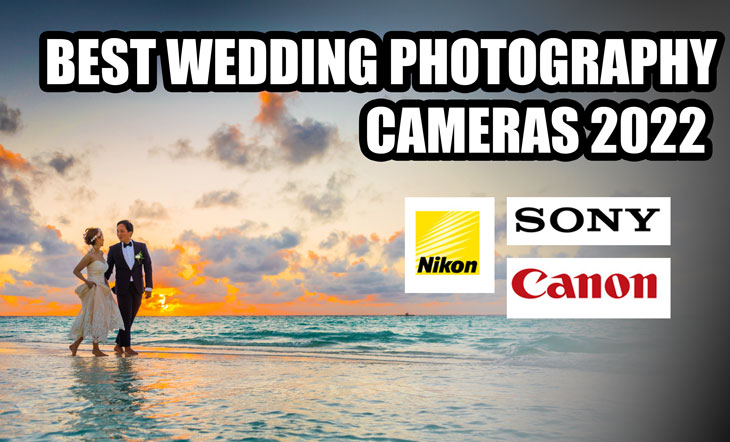
I get many requests from my subscribers and readers to suggest the best wedding photography camera and lenses for 2023. so in this article, you will get all the essential details related to camera gears and lenses required for wedding photography.
One of the most important parts of wedding photography or cinematography is the skill of the photographer. And the second most importantly the gear you have. So, in the article, we will discuss the best possible wedding photography gear you can buy with the budget you have. This is a custom-tailored wedding photography guide made for every budget.
SELECTING Lenses for Wedding Photography
For wedding photography, we generally recommend two lenses (at least you should have these two lenses) and the lenses are, the coverage lens and the portrait lens.
Coverage Lens
The coverage lens is specifically recommended for the wedding event when you cover the ring ceremony, group photo shoot, and other important rituals performed during that day.
Portrait Lens
For Pre-wedding shoot and boudoir photography, you need a portrait prime lens. So in this article, we are recommending you two basic essential lenses for every camera that falls in your budget range.
So let’s talk about the best wedding photography camera of 2023 let’s begin with the list. If you looking for a super budget wedding Photography guide and no matter what you get in your hand it should be a perfect system.
We are keeping DSLR recommendations
As usually you know the DSLRs are outdated and the DSLR makers are cannibalizing their DSLRs. The research and development on DSLR and their lenses also stopped so it’s worthless to recommend any DSLR camera for wedding photographers in the year 2023. in this article, we will be keeping out the DSLR cameras and that’s essential too.
1. Best Nikon Camera and Lens for Wedding Photo and Video
Nikon Z6 Mark II is the best camera for Wedding Photography and Video in 2023. If you are a Nikon shooter, we highly recommend that you get associated with Nikon Z6 Mark II in 2023.

Nikon Z6 Mark II with 24-70mm F4 and portrait lens
|
Nikon Z6 Mark II Camera with 28-75mm F2.8 Lens B&H Store
Optional – More affordable package – Nikon Z6 Mark II with 24-70mm F4 at Amazon.com
Nikon 85mm F1.8 Lens for Potraits Amazon.com | B&H Store |
The best wedding photography camera for the year 2023 is Nikon Z6 Mark II. Nikon Z6 Mark II camera is a very reasonable price camera, packed with amazing core specs. In that price range, no other camera maker offers such core specifications at such a price point.
Yeah, there was a time when we were recommending the Sony a73 camera to our users, but after the announcement of the Z6 mark 2 camera, everything changed. The Camera arrives with the enhanced core specification compared to the a73 so after that, we have started recommending the Z6 mark 2 camera.
Whether you are coming from Nikon D7500 or D750 this is a surprise upgrade for you. Nikon Z6II kit with the wonderful 24-70 f/4 S lens is a perfect combo for a wedding photographer. The IBIS in the Z6II is the best I ever used, I can handhold all the way down to 1/5th of a second with a 50mm lens! I don’t know what else to say about it, it’s an awesome camera and it works exactly the way it should. Easy to handle for my large hands and easier to walk around with.
| Nikon Z6 Mark II Pros |
Nikon Z6 Mark II Cons |
- Excellent image quality
- Best in class for oversampled 4K Video
- N Log 10 bit, HDR
- Professional Design and Controls
|
- None (best in class camera)
|
2. Best Sony Camera and Lens for Wedding Photo and Video
Sony A7 IV is the best Sony Camera for wedding photography and video. The Sony A7 IV features an amazing 33 MP resolution and allows you to capture 10-bit 4k Oversampled videos. If you are interested in Sony cameras then we highly recommend you get the Sony A7 IV camera for wedding photography and video purpose.
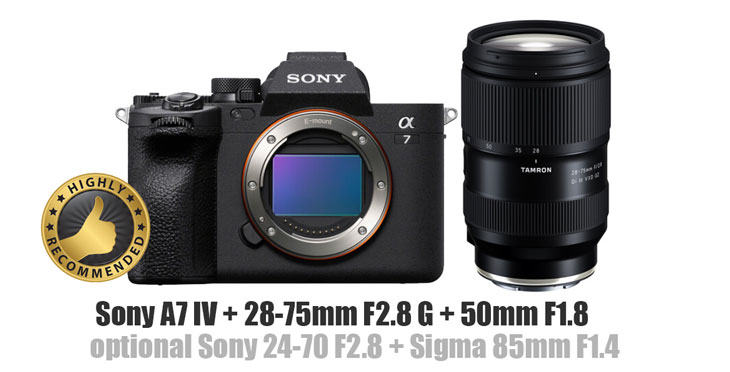
Sony A7 IV with Tamron 28-75 G2 Lens and a portrait lens
Sony A7 IV is an excellent camera for wedding photographers when paired with Tamron 28-75mm F2.8 Lens. The 28-75mm F2.8 acts as an event coverage lens as well as a candid photography lens. Even if you are a Canon user feel free to migrate since now you guys have S-Cinetone support that will generate perfect skin tones while shooting portraits or recording a video.
The problem with Sony A74 is the overheating issues. if you live in the Asian region or somewhere near the equator and the summer season temperature ranges somewhere around 35° to 40 degrees centigrade, then recording videos with an A74 camera will be not so easy. You will regularly get heat warnings and auto shut-down after a max of 25-30min of recording 4k videos. even after increasing its threshold value. For wedding Cinematographers, those who are near the equator or the summer temperature of your region ranges above 35 degrees and above you should have another option for cinematography or videography like we have the Sony A7C camera or the Sony A7S III.
also, look at Best Lenses for Sony A7 IV Camera
What Canon users say about Sony A7 iV
Sony A7IV after regular use of my Canon DSLRs. The A7IV is portable, lightweight and versatile, allowing me to move from taking stunning photos to recording video content for my clients which range from fashion to hospitality. Moving from photo to video shooting is smooth and does not break my workflow. I get to focus on capturing the moments. The kit is fantastic as-is, but I also purchased a 50mm 1.8 lens which I’ve been accustomed to shooting with. All in all, I would highly recommend the purchase if you’re in the market for a mirrorless camera.
What Nikon users say About Sony A7 IV
Coming from Nikon after 18 years it’s been a hard learning curve but worth every penny! Yes, the kit lens people say is a joke but it is what it is.I have made it work for studio work and am happy. Not a prime but it works. The camera is something else! Studio work, outdoors, birds, and sports it has done what I want and lots better. I am coming from a long line of Nikon cameras with the latest being the d750 and d850.
| Sony A7 IV Pros |
Sony A7 IV Cons |
- Excellent image quality
- Best in class for oversampled 4K Video
- S-Cinetone
- Professional Design and Controls
|
- Overheating in hot-humid weather
|
3. Best Budget Wedding Fullframe Camera from Sony
Sony A7C is the best budget full-frame Mirrorless camera of 2023 from Sony. You can use the camera for wedding photography and cinematography purpose. We highly recommend you to have this camera for prolonged video recording.

Sony A7C with Tamron 28-75 F2.8 G2 Lens
The Sony A7C is a budget full-frame cinema camera with Fastest Autofocus in its class. The Sony A7C is an incredible camera that outperformed my expectations, and highly recommended those who are into video. It has everything that a professional wedding photographer requires from a full-frame camera, you can shoot incredible still shots as well as you can also capture videos without any overheating issues.
The low light performance is outstanding, the overall image quality is superb, and the ergonomics of the camera work well, although you have slightly less physical control than the Sony A7 III. It feels like it’s a well-made/sturdy camera body but it’s not quite as large as other full-frame cameras that I’ve tried (small and compact). I recommend this camera to photographers or videographers of any skill level looking for a full-frame camera.
| Sony A7C Pros |
Sony A7C Cons |
- Excellent image quality
- Best in class for oversampled 4K Video
- N Log 10 bit, HDR
- Professional Design and Controls
|
- None (best in class camera)
|
4. Best Wedding Fullframe Camera from Canon
The best Canon camera for wedding photographers is Canon R5. The other budget solution is Canon R6 if you want to have a more affordable camera. We have also selected the best budget lenses for Canon R5 Camera for wedding photographers.

Canon R5 with 24-105mm F4 and 50mm F1.8
The Canon R5’s newly developed 45 Megapixel sensor is just amazing, I am not able to believe the number of details visible in the captured image. One of the most noticeable things is its low-light performance, despite having a conventional CMOS sensor the camera produces amazingly well low-light images with shadow details, its performance matches with competitors’ BSI CMOS sensor-based cameras.
Canon R5 features Canon’s advanced hybrid artificial intelligent autofocusing system, which covers approximately 99% area of the frame, and object tracking, face tracking, and eyes tracking are just amazing.
I’ve had the R5 only a couple of weeks now, but really love it. The level of detail we get from this camera and the autofocus methods including eye-tracking is amazing.
5. Wedding Camera Package Under $1500
Let’s have a look list of cameras and lenses we have for wedding photographers and wedding cinematographers under $1500. These are the best combos available in 2023.
Exceptional Camera under Affordable Price Tag

Sony ZV-E10 for Wedding Cinematography and casual clicks Under $1500
We are not able to keep this camera despite its production line issues.
Most of the time the camera remains out of the stock due to its high demand or the chip shortage Sony may be facing this time.
Sony ZV-E10 is an excellent camera without a doubt and if you are a videographer or a cinematographer or even if you are a photographer this camera will going to full fill all of your needs flawlessly.
| Pros |
Cons |
- Excellent image quality
- Best in class for 4K Video
- Oversampled video quality
- Easy to use,
- has lots of controls
- Work as webcam
- Perfect for Shooting Reels
|
- No battery Charger included
|
Sony ZV-E10 camera is one of the best and class-leading cameras, if we compare the specification against its competitors in the same price range, You will find Sony ZV–E10 is way ahead of others.
This camera is very similar to my a6400 for hundreds less. Same battery. Great vlogging camera at this price point. This camera has great features including 4k video and eye-tracking for clarity. The kit lens works better than I expected for videos.
The built-in mic is pretty good if you don’t want to carry around an external mic. I’d recommend purchasing the tripod with remote control. It works great on this camera and has cool features as well.
I’d recommend buying 2 extra batteries and an external battery charger. Out of the box you have to plug the entire camera into the outlet for the battery to charge. Happy vlogging everyone!
Nikon Z50 Camera for Wedding Photographers

|
Nikon Z50 with 16-50 Lens (Basic kit lens will act as a coverage lens) B&H | Amazon.com
Viltrox 56mm F1.4 for candids & Portraits for pre-wedding shots B&H | Amazon.com |
About Nikon Z50 Mirrorless Camera
One of the most affordable cameras to start with is undoubtedly the Nikon z50. Nikon z50 is one of the best low light cameras for wedding photography purposes, you can start with the kit lens and later you can upgrade it to an 18 to 140 MM lens. And now we also have viltrox lenses support that you can buy for portrait photography or candid photography purpose.
About Viltrox 56mm F1.4 Lens for Nikon
really great value lens that produces incredible results. It is very sharp wide open and offers excellent subject separation with great background blur. Well worth the money.
| Pros |
Cons |
- Excellent image quality
- Best in class low light performance
- Oversampled video quality
- Comfortable, well-placed controls
- Plenty of customization
- Rapid stills/video switching
- USB charging
- Fairly simple Wi-Fi image transfer
|
- No IBIS
- Lens availability /
- reliance on adapted lenses may be limiting
- Middling battery life
|
Nobody is paying attention to this little camera because it does not have the pro specs, it’s no dual card slot, it’s only 20.9 MP, it’s a huge mount with a small sensor, full-frame is better than APS-C, the lens selections are not good, blah…blah..blah… Everyone is missing out on the intention Nikon has on this camera and that is the FUN factor in photography. I have used Nikon D7100, D810, D850, D500, and the Z7. All of them are really great cameras. Well constructed, weather-sealed, rugged, and most of all aimed for professional use. I also have a bunch of Nikon lenses that you can say are also pro-grade. When Nikon first announced this camera I was not really thrilled like the way I was when they debuted the D850 and Z6/7. And like everyone before investing on new equipment I do research first before committing. When it became available for pre-order I went ahead and took the dive of getting one. Now that I tried it I was amazed at how compact this camera is. It literally a pocketable camera like its point and shoot cousins. The capabilities in stills and video is on par with my D500 except of the size, additional features, and weight. I take this camera with me most of the time than my other ones. It’s fun to shoot it. IMO it’s a better alternative than using my smartphone for taking photos at least the shape is familiar for me with that DSLR/Mirrorless feeling in your hand. The size makes good use for candid and street photography because it’s less noticeable and discrete. It’s a well-rounded camera for taking almost any kind of photography. The 20.9MP is just within the sweet spot for resolution good enough for a 13 x 19 size printout. I do not pixel peep or even scrutinize the resolution like Youtuber reviewers do because at the end of the day what matters most it your overall satisfaction with the product since you are the user.
If You are looking for a super budget wedding package then you should go with the Nikon Z50 camera, the camera features a perfect 20M low-light Sensor for perfect output during wedding sessions.
IF YOU STILL HAVE ANY QUESTIONS RELATED TO WEDDING PHOTOGRAPHY GEARS PLS FEEL FREE TO ASK IN THE COMMENTS SECTION BELOW OR YOU CAN EMAIL TO US AT THENEWCAMERA[AT] GMAIL.COM
Also, look at
Best Sony Cameras of 2022
By admin, on June 30th, 2021

Nikon Zfc vs Nikon Z50 specification comparison review. Did both the camera features exactly the same core specification or they do have some differences between them. Let’s find out in our detailed specification comparison review.
1. Sensor Comparison Nikon Zfc vs Nikon Z50
| Nikon Z |
Nikon Z |
| APS-C (1.5x Crop Factor) |
APS-C (1.5x Crop Factor) |
Actual: 21.51 Megapixel
Effective: 20.9 Megapixel (5568 x 3712) |
Actual: 21.51 Megapixel
Effective: 20.9 Megapixel (5568 x 3712) |
| 1:1, 3:2, 16:9 |
1:1, 3:2, 16:9 |
| CMOS |
CMOS |
| 23.5 x 15.7 mm |
23.5 x 15.7 mm |
| JPEG, Raw |
JPEG, Raw |
| 14-Bit |
14-Bit |
From the initial set of specifications, it’s very clear that both Nikon Zfc and Nikon Z50 camera features the same sensor.
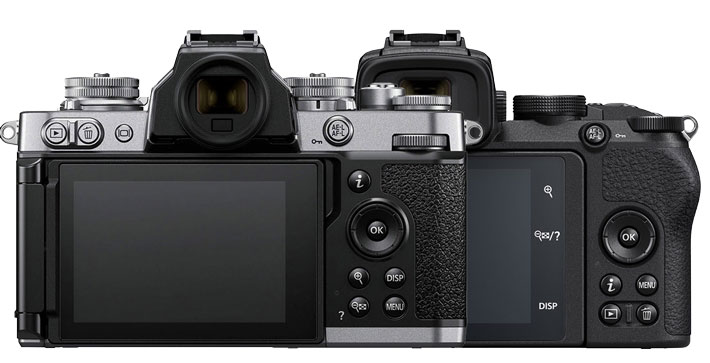
2. Continuous AF Speed, Exposure Control and ISO
| ISO Sensitivity |
Auto, 100 to 51200 (Extended: 100 to 204800) |
Auto, 100 to 51200 (Extended: 100 to 204800) |
| Shutter Speed |
Electronic Front Curtain Shutter
1/4000 to 30 Second
Bulb Mode
Time Mode
Electronic Shutter
1/4000 to 900 Second
Bulb Mode
Time Mode |
Electronic Front Curtain Shutter
1/4000 to 30 Second
Bulb Mode
Time Mode
Electronic Shutter
1/4000 to 30 Second
Bulb Mode
Time Mode |
| Metering Method |
Center-Weighted Average, Matrix, Spot |
Center-Weighted Average, Highlight Weighted, Matrix, Spot |
| Exposure Modes |
Aperture Priority, Manual, Program, Shutter Priority |
Aperture Priority, Manual, Program, Shutter Priority |
| Exposure Compensation |
-5 to +5 EV (1/3, 1/2 EV Steps) |
-5 to +5 EV (1/3, 1/2 EV Steps) |
| Metering Range |
-4 to 17 EV |
-4 to 17 EV |
| Continuous Shooting |
Up to 11 fps at 20.9 MP |
Up to 11 fps at 20.9 MP
Up to 5 fps at 20.9 MP
Up to 4 fps at 20.9 MP
Up to 30 fps at 8 MP |
| Interval Recording |
Yes |
Yes |
|
|
2/5/10/20-Second Delay |
We are not able to spot any minor difference between these two cameras. It looks like a Nikon Z50 camera wrapped inside a Nikon Zfc body.
3. Best Video Camera between the Nikon Zfc and Nikon Z50
| Recording Modes |
H.264/MOV/MP4
UHD 4K (3840 x 2160) at 23.976p/25p/29.97p
Full HD (1920 x 1080) at 23.976p/25p/29.97p/50p/59.94p/100p/119.88p |
MOV/MP4/H.264
UHD 4K (3840 x 2160) at UHD 4K (3840 x 2160) up to 29.97p
Full HD (1920 x 1080) up to 120p |
| Recording Limit |
Up to 29 Minutes, 59 Seconds |
Up to 29 Minutes, 59 Seconds |
| ISO Sensitivity |
Auto/Manual: 100 to 25600 |
Auto/Manual: 100 to 25600 |
| Audio Recording |
Built-In Microphone (Stereo)
External Microphone Input (Stereo) |
Built-In Microphone (Stereo)
External Microphone Input (Stereo) |
| Live Streaming |
Yes |
Yes |
| Webcam Functionality |
Yes |
Yes |
|
|
|
The video specification of both Nikon Zfc and Nikon Z50 exactly the same.
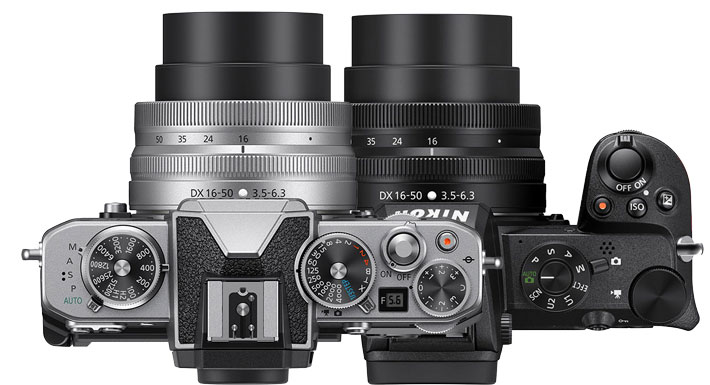
4. Autofocus Speed
| Focus Type |
Auto and Manual Focus |
Auto and Manual Focus |
| Focus Mode |
Automatic (A), Continuous-Servo AF (C), Manual Focus (M), Single-Servo AF (S) |
Automatic (A), Continuous-Servo AF (C), Full-Time Servo (F), Manual Focus (M), Single-Servo AF (S) |
| Autofocus Points |
Phase Detection: 209 |
Phase Detection: 209 |
| Autofocus Sensitivity |
-4.5 to +19 EV |
-2 to +19 EV |
5. Viewfinder and monitor
| Viewfinder Type |
Electronic (OLED) |
Electronic (OLED) |
| Viewfinder Size |
0.39″ |
0.39″ |
| Viewfinder Resolution |
2,360,000 Dot |
2,360,000 Dot |
| Viewfinder Eye Point |
20 mm |
20 mm |
| Viewfinder Coverage |
100% |
100% |
| Viewfinder Magnification |
Approx. 1.02x |
Approx. 1.02x |
| Diopter Adjustment |
-3 to +3 |
-3 to +3 |
|
|
3.2″ |
| Resolution |
|
1,040,000 Dot |
| Display Type |
Vari-angel |
180° Tilting Touchscreen LCD |
Verdict
The core specification of both the camera is almost same. But as you can see we have 4 major differences from the Nikon Z50 camera.
- Extensive manual control
- Vari-angle display screen
- Advance AI AF in camera
- USB power
Why Nikon Z50 is still good for photographers
- Excellent handgrip that Nikon Zfc doesn’t have
Get Nikon Z50 from Amazon.com
Get Nikon ZFc From B&H Store and Amazon.com
Best lenses for Nikon Z50
By admin, on December 18th, 2020

In a recent interview with an amateur photographer, Nikon Rep confirmed that they are working on DX-format line-up and more lenses are on the way. Take a look at the Major points of the interview
- Nikon on 2020 and COVID-19: “As an initial reaction to COVID-19, we saw a halt in customer purchasing. Consumer demand began to drop throughout the world. When consumer demand fluctuates so much, any manufacturer will be faced with challenges relating to the supply chain. Although we are not totally back to normal levels, we have thankfully seen a healthy recovery, much better than what we had originally anticipated. Global demand is returning strongly.“
- The new Nikon D780, Z6 II, and Z7 II cameras have been well-received by the market with “steady” sales.
- More DX-format lenses for Z-mount are on the way.
- Nikon expects the production of some DSLR cameras and F-mount lenses to be impacted by the fire at AKM Semiconductor in Japan.
- The remaining questions were answered with the standard for Nikon “While we cannot comment on future products, we are constantly evaluating the needs of the market in order to respond accordingly“.
We will update you soon as we get more information
via NR.com source amateurphotographer.co.uk
|
KEEP THIS BLOG ALIVE - Support New Camera Buy Canon Lenses, Buy Music CD or Digital Camera at amazon it helps this site, and you do not pay anything extra, it is just a way to help support this site.

|




































